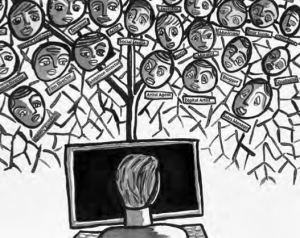Too Many Friends

Robin I. M. Dunbar, an evolutionary anthropologist and primate behavior specialist, addresses this question in a neuro-cognitive theory known as “the social brain hypothesis.” Dunbar has found a positive correlation between the size of different primate species’ neocortex (the part of the brain responsible for consciousness and reasoning) and the size of their social networks.
He suggests that the brain has a limited capacity for keeping track of social relations beyond a certain number. For humans, the mean number, he says, is 150—now known as “Dunbar’s number.”
The average internet user who “follows” individuals on Twitter, “friends” people on Facebook, and gets “LinkedIn” with other professionals, “knows” many people. According to the June 2011 report by the Pew Internet & American Life Project, the average American social network site user has 636 social ties, and those numbers are only going up. Nielsen Media Research reports an increase from 2010 to 2011 in social networking activity in every internet-connected demographic group studied, around the globe.
By pushing our cognitive limits, Dunbar’s theory suggests, social ties may become more diffuse; social relationships may grow increasingly casual and less bounded by reciprocity and commitment.
Some sociologists say there’s little cause for alarm. Writing in the British Journal of Psychology last year, Barry Wellman, a leading authority in social network analysis, suggests that human social networks are too complex and comprised of too many kinds of social relations to be characterized by one number. It is also possible that our brains may further develop to accommodate these enlarged networks.
Or we may succumb to Facebook fatigue, cancel our accounts and return to more “personalized” modes of interaction.
